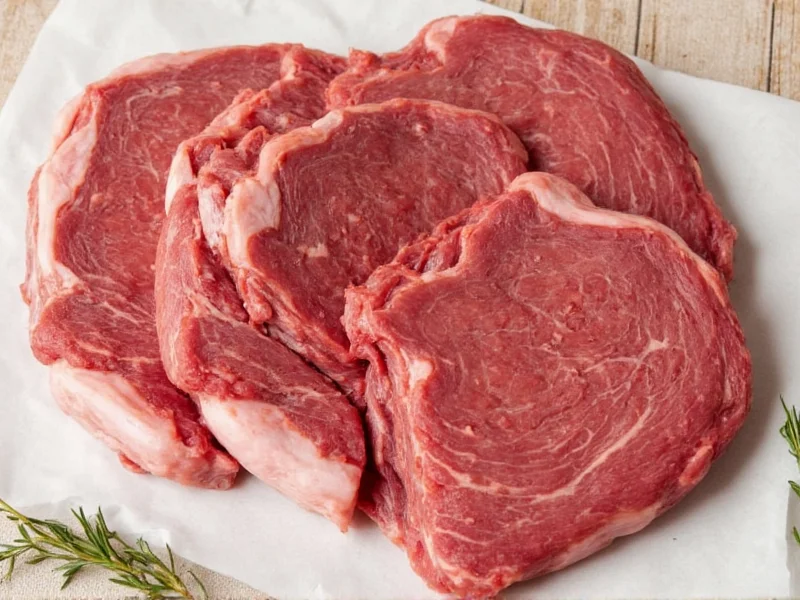Understanding Roast Beef Seasoning Fundamentals
Seasoning roast beef properly transforms a simple cut of meat into a culinary masterpiece. The right combination enhances the natural beef flavor without overpowering it. Different cuts require slightly different approaches—tougher cuts like chuck benefit from bolder seasonings, while premium cuts like ribeye shine with simpler preparations.
Essential Roast Beef Seasoning Components
Every successful roast beef seasoning starts with these core elements that work in harmony with beef's rich umami profile:
Salt: The Flavor Activator
Coarse sea salt or kosher salt is non-negotiable. Salt doesn't just add flavor—it breaks down muscle fibers, allowing seasonings to penetrate deeper. For best results, use 1 teaspoon of salt per pound of meat and apply it at least one hour before cooking. This dry-brining technique yields significantly more flavorful and evenly seasoned results than seasoning immediately before cooking.
Freshly Ground Black Pepper: The Aromatic Foundation
Freshly cracked black pepper provides complex floral and earthy notes that pre-ground pepper lacks. Use a generous amount—about 1/2 teaspoon per pound—as pepper's volatile compounds mellow during cooking. For special occasions, consider blending in a small amount of Tellicherry or Sarawak pepper for additional complexity.
Garlic: The Flavor Catalyst
Fresh garlic cloves, either minced and rubbed directly onto the meat or inserted as slivers, create delicious flavor pockets. As the roast cooks, garlic's sulfur compounds transform into savory, meat-enhancing aromatics. Avoid garlic powder, which can burn and turn bitter during roasting.
Classic Herb Combinations
Fresh rosemary and thyme are the traditional herb pairing for roast beef. Rosemary's pine-like intensity complements beef's richness, while thyme adds subtle floral notes. Use whole sprigs rather than chopped herbs—they're easier to remove after cooking and release flavor more gradually. For every pound of beef, use 2-3 small sprigs of each herb.
| Seasoning Combination | Best For | Application Method |
|---|---|---|
| Salt, pepper, garlic, rosemary, thyme | All cuts, especially ribeye and sirloin | Rub directly on meat 1-2 hours before cooking |
| Mustard powder, smoked paprika, garlic powder | Chuck roast, round roast | Create paste with olive oil, apply 4+ hours before |
| Horseradish, Worcestershire, black pepper | Leftover roast beef sandwiches | Mix with mayo for finishing sauce |
| Herbes de Provence, lemon zest, garlic | Tenderloin, filet mignon | Light coating 30 minutes before cooking |
Advanced Seasoning Techniques for Perfect Roast Beef
Once you've mastered the basics, these professional techniques will elevate your roast beef to restaurant quality:
Dry Brining vs. Wet Marinades
Dry brining (salting in advance without liquid) is generally superior for roast beef as it concentrates flavor while improving texture. Wet marinades work better for tougher cuts that need tenderizing. For most roasts, a simple dry brine of salt, pepper, and herbs applied 12-24 hours before cooking yields the best results—moisture is drawn out initially, then reabsorbed along with seasoning flavors.
Layering Flavors at Different Stages
Professional chefs often season at multiple stages:
- Before cooking: Salt and dry rub for deep flavor penetration
- During cooking: Baste with pan juices containing aromatics
- After cooking: Finish with flaky sea salt and fresh herbs
This creates complex flavor dimensions rather than a single-note seasoning profile.
Regional Flavor Variations
Adapting traditional seasoning approaches from different culinary traditions can yield exciting results:
- French style: Dijon mustard, herbes de Provence, and cognac
- British style: English mustard powder, horseradish, and ale reduction
- Mediterranean style: Oregano, lemon zest, and olive oil paste
- Asian fusion: Soy sauce, ginger, and five-spice powder (use sparingly)
Common Seasoning Mistakes to Avoid
Even experienced cooks make these seasoning errors that compromise roast beef quality:
Seasoning Too Late
Applying seasoning immediately before cooking only flavors the surface. For proper penetration, season at least one hour before (preferably 12-24 hours for dry brining). This allows time for salt to break down proteins and distribute seasoning flavors throughout the meat.
Overcomplicating the Blend
With roast beef, less is often more. Using too many competing flavors creates confusion rather than complexity. Stick to 3-5 primary seasonings that complement rather than compete with beef's natural flavor. Reserve complex spice blends for tougher cuts that need additional flavor support.
Ignoring the Resting Period
Seasoning continues to work during the crucial 15-30 minute resting period after cooking. Covering the roast loosely with foil creates a steamy environment that helps distribute seasoning flavors evenly throughout the meat. Never skip this step—properly rested meat yields more consistent seasoning from edge to center.











 浙公网安备
33010002000092号
浙公网安备
33010002000092号 浙B2-20120091-4
浙B2-20120091-4